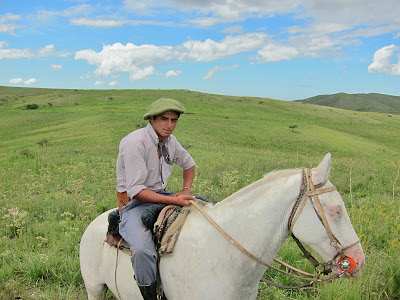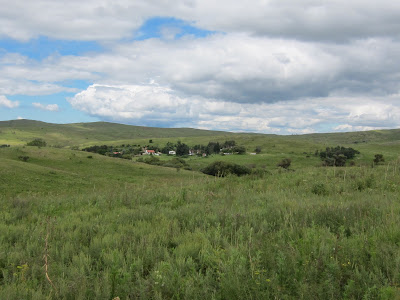Did I learn to ride a horse? Weeeeellll..... I did go out twice a day for a total of about 5 hours a day, and did manage a few canters but I don't think I am a natural rider. However Los Potreros is well used to novices and the English guides and the Argentine gauchos are infinitely patient.
Novice riders are treated with as much consideration and shown as much of the gorgeous countryside as the professional riders. It is certainly an ideal place for a beginner rider as well as for the most experienced. They also have a polo ground and many people go there to play polo--not me!
I have learned that there are some places which you cannot hope to see properly unless you ride, and the Cordoba sierra is one such place. The estancia is huge---5000 acres---and you can ride for days without ever duplicating a ride.
There are valleys with streams and pools and waterfalls and there are rocky hillsides with magnificent wild flowers and high ridges with views to die for. You would have to be a very fit and enthusiastic hiker to see everything I saw and you could never dream of seeing the rocky hilly terrain in a vehicle.
I have also gained a bit more understanding of that extraordinary creature, the horse. Such a huge animal on such tiny legs. The legs are not even legs as we know them---the hoofs have evolved from what we have as fingers and toes with the hard hoof being the fingernail. The fetlock is the equivalent of our wrist, what looks like the knee is the elbow. And the horse, despite its size, is a timid creature, startled by odd sounds and sudden movements.
Of the 55 or so riding horses on the estancia, about half are criollos which have a distinctive stripe down their spine and lower legs that are striped almost like a zebra The other half are paso peruanos, a special breed originally reserved for the Peruvian aristocracy, which has a fifth gait---a very smooth fast walk, which a fellow guest described as riding on a sofa. It is genetic and if the pasos are cross bred with any arab horses they lost the gait. All the horses on the estancia are grass fed only--there is so much land and such rich grass that they need no other hay or oats as supplements.
As I mentioned in my last post the estancia is also a working cattle ranch with 550 head of purebred Aberdeen Angus--you have to pass three massive bulls grazing beside the 5 km of rutted dirt road which leads of the main road into the estancia. Over the course of the week's rides I went to the cattle station where the cattle roam the hillsides.
Interestingly, neither the cow nor the horse are native to Argentina and were brought by the Spanish . Because of the hardships and false starts of the early years of the Spanish occupation of Argentina (early 1500s) many of these cattle and horses escaped and became wild and multiplied prolifically on the lush pampas. The gauchos, poor Spanish peasants who were brought over as settlers and intermarried with the indigenous tribes, learned to ride the now-wild horses and roamed the vast pampas, living in the saddle and feeding on the wild cattle. It was not until the 19th century when the huge waves of European settlers arrived that the pampas were fenced and the gauchos and the horses and the cattle were tamed again as the servants of the Europeans.
The estancias on the Cordoba sierras were different from the ones nearer Buenos Aires, however. For one thing they are much older and for another they are on the slopes of the sierras rather than on flat land. This makes then much more interesting for a visitor and rider.
Cordoba is right in the middle of Argentina and hundreds of miles from the sea and yet was a thriving city hundreds of years before Buenos Aires was anything more than a muddy town. The reason was that Cordoba was the breadbasket which was closest to the real heart of the Spanish empire in South America, which was Chile and Peru .
It was from mines of Peru and Bolivia that the Spanish got the silver that made Spain the colonial force that it was and filled the Spanish galleons that crossed the Atlantic and were prey to the English pirates. The mules which worked in the mines were bred on the estancias of Cordoba and the food and supplies for the mining operations moved from the Cordoba pampas and sierras up north ( to the area I am now travelling to ) and over the border into Bolivia and on to Peru (of course there were no borders then and the whole of this vast area was ruled from Lima in what is now Peru and from Santiago in present day Chile).
And then there were the Jesuits. Cordoba was the centre of Jesuit power and wealth in South America from early 1600s to the 1760s. And hugely wealthy and powerful they were. That was ultimately their downfall since they became too powerful for the King of Spain's liking and they were expelled. However they left behind huge estancias and beautiful churches and schools and monasteries. Interestingly, Los Potreros was founded at the same time as the Jesuit estancias but never fell into their hands.
I see that I have wittered on about the history without really giving any sense of the beauty of the landscape.
My favourite ride was to the" top of the world" which really did seem like that. from the ridge you can look right to the pampas and the city of Cordoba spread out below you. To the left is the vast valley between the Sierra Chica and the next range which is the Sierra Grande. High above you soar condors and eagles . At lower heights are caracaras and the odd vulture. Lower still are the lapwings and swallows and even little green parrots. On the ground in the grass and among the rocks are the burrowing owls and the partridges. The wild flowers are so beautiful and varied that I have not hope of naming them--and in brilliant colours of blue, mauve, pink, white, yellow. Below are some pictures which are a poor substitute for the real thing or the right words to describe them.
I left the estancia on Friday morning and rented a car for two days driving around the Cordoba area. One particularly fine excursion was to the 2000 metre high pass over the Sierra Grande where the Andean condors teach their young to fly. The road is magnificent as it climbs up to the Sierra Grande, and the treeless boulder-strewn terrain is dramatic--solid smooth time-worn granite.
I also visited the small city of Alta Gracia which has one of the largest and best preserved of the Jesuit estancias.There is also a quite interesting Che Guevara museum --his family lived in Alta Gracia while he was growing up and the museum is in one of the homes they lived in in the city--a simple suburban house. Having seen all the Che museums and memorials in Cuba a few weeks ago (you can't avoid them!) I thought I'd see the one in Alta Gracia. It is well done with lots of photos and memorabilia, if you care for that sort of thing.
I also visited Villa Belgrano and La Cumbrecita which are about 100 km to the south of Cordoba city.Villa Belgrano is a faux German town with loads of schwartzwald-type houses and beer steins and lederhosen. I guess it is not really "faux" since it was settled by the german sailors who survived the scuttling of the Graf Spee and who were moved inland rather than being imprisoned since Argentina was neutral at the time.
La Cumbrecita is also a German alpine village but with a different history--it was created out of a desolate treeless valley up in the Sierra Grande by a German family who came to Cordoba to run the Siemens factory in the early 1930s. It is a lovely setting with a fine river and waterfalls and plenty of hiking and climbing trails and horseriding, as well a lots of rather more authentic alpine houses and hotels.
I finished up in Cordoba city last night. What a dump! Despite its long history and its fine location it has been completelydestroyed by thoughtless modern commercial development and unsympathetic architecture with no thought for the heritage that has been lost forever. Cheap shopping centres and McDonalds next to 500 year old Jesuit seminaries. Those poor old Jesuit churches and convents look positively embarrassed to be surrounded by such tat! It rather makes one wish that the Spanish Inquisition could be revived to try the Cordoba city fathers for their heresy.
Trivia
The Argentinians are very keen on soft drinks--coke, fanta, lemonade primarily. They drink these sweet drinks with their meals, particularly the women. So you see a couple tucking into a huge steak which the lady is washing down with a glass of coke --yugh! And the man may be drinking a red wine but he will have ordered a bucket of ice cubes which he loads into the red wine glass--double yugh!
Next post will be probably not be until the end of this week since I will be off-piste travelling in Argentinian equivalent of the outback.
 |
| The estancia buildings |
 |
| the lawns of the estancia compound |
 |
| Pedro, one of the gauchos |
 |
| Meadows with the estancia compound amongst the trees in the distance |
 |
| Horses beside one of the pools on the estancia |
 |
| some of the Aberdeen Angus cattle at the cattle station on the estancia |
 |
| one of the views on one of the rides. Note the dry stone wall in the foreground--these are several hundred years old and date from when the estancia bred mules for the silver mines in Bolivia |
 |
| look at that view! |
 |
| fresh eggs for breakfast every morning (not from him of course!) |
 |
| Note the contours of the hills--they look like green sand dunes |
 |
| View into the valley between the Sierra Chica and the Sierra Grande |
 |
| There are many brooks and rivers crossing the estancia. This waterfall and pool are particularly attractive |
 |
| The Jesuit estancia and church at Alta Gracia |
 |
| Che Guevera's childhood home in Alta Gracia |
 |
| waterfall and pools at La Cumbrecita |
 |
| One of the alpine houses in La Cumbrecita |
 |
| The barren granite hills near La Cumbrecita |
 |
| The bridge at the entrance to La Cumbrecita |
 |
| The sierras around La Cumbrecita |
 |
| Countryside around La Cumbrecita |
 |
| The faux German town hall in Villa Belgrano (see blog) |
 |
| They celebrate Oktoberfest in Villa Belgrano, but in April! |
 |
| The river that runs through La Cumbrecita--very popular for swimming |
 |
| Los Molinos--an artificial lake created by a damn built in the 1950s |
 |
| Los Molinos again. The artificial lake has now become a recreation area---note the houseboat, which seems to be the favourite holiday home on the lake |
 |
| Up on the pass over the Sierra Grande where the Andean condors learn to fly |
 |
| There are quite a few of these drive-through rivers in the countryside around Cordoba |




No comments:
Post a Comment